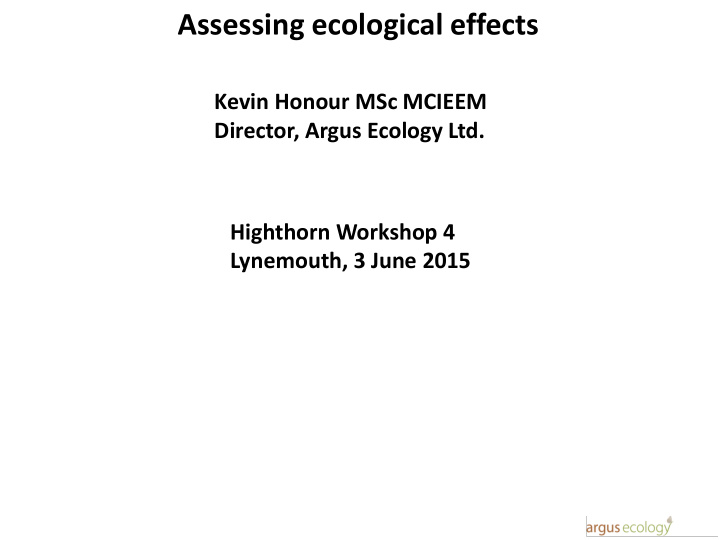



Assessing ecological effects Kevin Honour MSc MCIEEM Director, Argus Ecology Ltd. Highthorn Workshop 4 Lynemouth, 3 June 2015
Assessing ecological effects Gather data about the site and its surroundings • Collate existing data (ERIC, WeBS, Bat Group, Bird Atlas data) • Consult with Natural England, County Council, Wildlife Trust etc. • Carry out a programme of ecological surveys • Adjust survey programme in response to results and feedback Assess the effects of the surface mine • Identify importance of wildlife within and around the mine • Take account of other environmental studies (noise, hydrology etc.) Incorporate the needs of wildlife into site operations and restoration • Managing land for wildlife during coaling • Building in net gains for wildlife with restoration
Surveys carried out Habitat, tree and hedgerow surveys Protected species surveys (otter, great crested newt, red squirrel and badger) Bird surveys • Winter bird surveys – farmland and coast, vantage point surveys • Breeding bird surveys
Protected species surveys Otter surveys of streams Looking for signs of squirrel and badger activity Camera trap surveys Bat surveys – transects, emergence surveys of buildings, automated monitoring using recording equipment
Winter bird surveys • Farmland Bird Survey (including dune grassland and Chibburn area – over 300km walked over 9 winter months October 2012 – December 2014) • Geese and swan surveys – watching movements from vantage points 1 hour before to 1 hour after sunrise and sunset • Coastal bird surveys – ca. 4.5km section of Druridge Bay • Drive around surveys – trying to find geese in wider area (south to Woodhorn / Linton, north to Country Park / Maidens Hall) • Over 5000 records generated from surveys, over 150 species recorded in total
Natural England advice: • “ Bird surveys should be undertaken in a variety of different weather conditions”
Summer bird surveys Breeding bird surveys • Standard 3-visit survey starting at / shortly after dawn, in April, May and June 2014 • Area of survey extended to south in 2015 • Some observations in post-breeding / autumn migration periods • Other specialist surveys for protected bird species
Key results • Surface mine avoids statutory and locally designated sites • Site generally open – few hedgerows, one plantation and one pond • Otter, great crested newt, red squirrel and badger in wider survey area, not dependent on site • Bat activity including Nathusius ’ pipistrelle • Brown hare throughout survey area
Habitats & hedgerows
Nathusius ’ pipistrelle
Bird survey results Pink-footed geese Internationally important numbers in 2012-13 (5000+) Lower numbers in subsequent winters (<4000) Significant changes in cropping and levels of deliberate disturbance / shooting between years
Coastal survey results Very strong negative correlation between numbers of dogs and sanderling (r =0.902, n =6, p = <0.02)
Breeding bird survey results 2014 results: • 651 at least ‘possible’ breeding territories from whole survey area • Estimated 85 chaffinch, 73 skylark and 38 tree sparrow pairs • Skylark (26), lapwing, yellowhammer (both 6), reed bunting and yellow wagtail (both 3) key breeding species of site
Mitigation and enhancement Key actions: • Site ‘Biodiversity Action Plan’ targeted at key species within site – brown hare, farmland birds such as skylark and yellowhammer • Off-site measures to maintain pink-footed goose population in wider area • Measures to minimise noise, avoid effects on water quality and reduce light spillage will help avoid impacts on surrounding habitats • Positive enhancement built into restoration
Recommend
More recommend